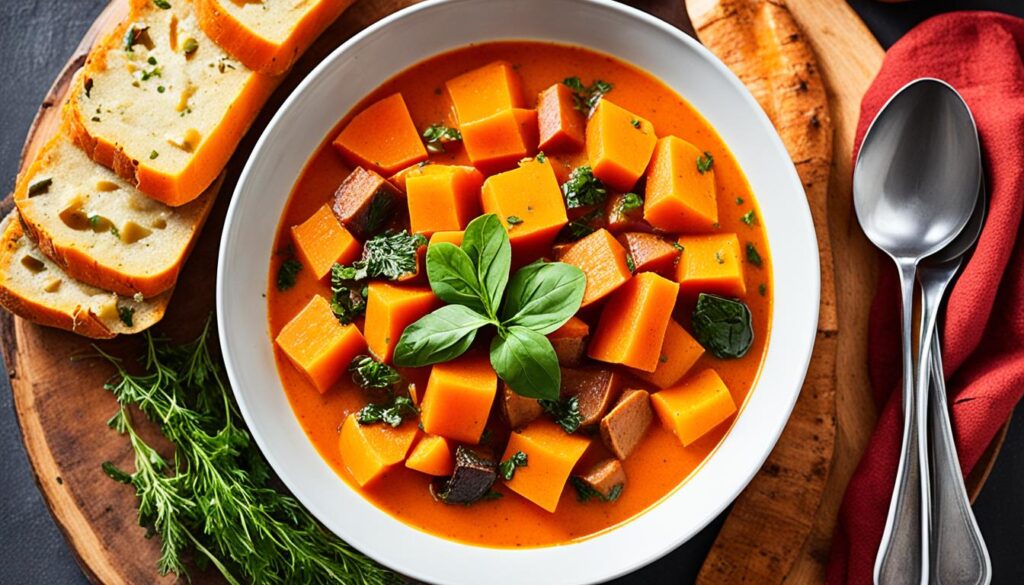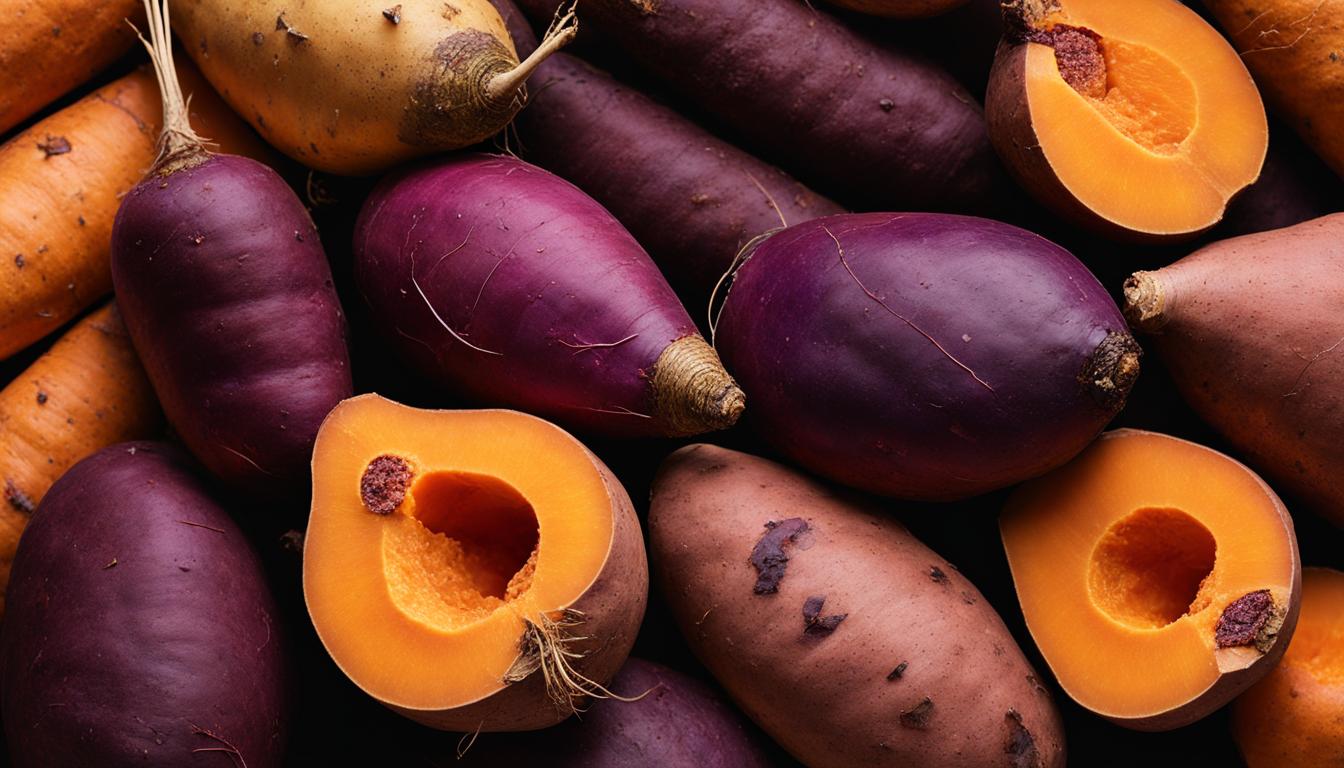Have you ever wondered about the difference between yams and sweet potatoes? Are they really the same thing? Prepare to have your assumptions challenged as we delve into the intriguing world of yams.
Most people use the terms “yam” and “sweet potato” interchangeably, but they are not actually the same root vegetable. So, what are yams, and how do they differ from sweet potatoes? Let’s discover the truth behind these misunderstood vegetables and unveil their secrets.
Key Takeaways:
- Yams are a distinct type of root vegetable, often mistaken for sweet potatoes.
- Yams have a woody, fibrous texture and a bland taste, while sweet potatoes have a softer, creamier texture and a sweeter taste.
- Yams are highly nutritious, packed with fiber, vitamins, and minerals.
- Yams are commonly used in African cuisine and can be cooked in various ways.
- Understanding the differences between yams and sweet potatoes is essential for proper usage and appreciation of their unique qualities.
The Nutritional Benefits of Yams
Yams are an incredibly nutritious root vegetable that offer a wide range of health benefits. They are packed with essential nutrients that support overall well-being and contribute to a healthy lifestyle.
Fiber for Digestive Health and Weight Management
Yams provide an excellent source of dietary fiber, which plays a crucial role in promoting healthy digestion and maintaining a healthy weight. Fiber adds bulk to the diet, helping prevent constipation and supporting regular bowel movements. It also promotes feelings of fullness and helps control appetite, making it easier to maintain a healthy weight.
Vitamins and Minerals to Support Immune Function and Skin Health
Yams are rich in vitamins A, C, and B6, as well as minerals like potassium, manganese, and copper. These nutrients are essential for various bodily functions, including immune function and skin health. Vitamin A is crucial for maintaining healthy vision and boosting immune responses. Vitamin C acts as an antioxidant, protecting cells from damage and promoting collagen production. Vitamin B6 supports brain development and function. Potassium, manganese, and copper are involved in energy production, bone health, and antioxidant defenses.
Antioxidants for Disease Prevention
Yams are also high in antioxidants, which help protect the body against oxidative stress caused by harmful free radicals. Antioxidants play a crucial role in reducing the risk of chronic diseases, such as heart disease, cancer, and age-related macular degeneration. Including yams in your diet can help boost your antioxidant intake and support optimal health.
Low Glycemic Index for Blood Sugar Control
One unique advantage of yams is their low glycemic index. This means that they release sugar into the bloodstream slowly, preventing rapid spikes in blood sugar levels. For individuals with diabetes or those looking to manage their blood sugar levels, yams can be a suitable choice. The low glycemic index of yams also helps provide sustained energy throughout the day and promotes stable moods and focus.
The Culinary Uses of Yams
Yams are a versatile ingredient that can be used in a variety of dishes. Whether you prefer them savory or sweet, yams offer endless possibilities in the kitchen. From comforting stews to indulgent desserts, there’s a yam recipe to satisfy every craving.
One of the most popular ways to enjoy yams is by boiling or steaming them. This simple cooking method helps to soften the yam’s texture while preserving its natural sweetness. Boiled or steamed yams can be enjoyed on their own as a nutritious side dish or added to soups and stews for an extra dose of flavor and heartiness.
If you’re in the mood for something crispy and indulgent, try making yam fries or chips. Sliced yams are tossed in oil and seasonings, then baked until golden and crispy. The result is a delicious alternative to traditional potato fries that pairs perfectly with burgers, sandwiches, or simply on their own as a tasty snack.
For a comforting and satisfying main course, consider making a yam and black bean stew. This hearty dish combines the earthy flavors of yams and black beans with aromatic spices like cumin and chili powder. It’s a one-pot wonder that is both nourishing and bursting with flavor.
If you’re looking to add some international flair to your menu, try making a yam and coconut soup. This Thai-inspired dish features the creaminess of coconut milk, the heat of Thai curry paste, and the subtle sweetness of yams. It’s a combination that will transport your taste buds to exotic destinations.
And let’s not forget about the sweet side of yams. Yam pudding is a classic dessert that highlights the natural sweetness and creamy texture of cooked yams. It’s often flavored with warm spices like cinnamon and nutmeg, and can be enjoyed warm or chilled for a delightful treat.
Yam Recipe Ideas
- Yam fries
- Yam and black bean stew
- Yam and coconut soup
- Yam pudding
Try this delicious yam and coconut soup recipe:
“Creamy, aromatic, and full of flavor, this yam and coconut soup is a perfect blend of comforting and exotic. The natural sweetness of yams combined with the richness of coconut milk creates a truly memorable dish. Serve it as a starter or pair it with a fresh salad for a satisfying meal.”
| Ingredients | Instructions |
|---|---|
|
|
Whether you’re a fan of savory or sweet dishes, yams can elevate your culinary creations. With their versatility and nutritional benefits, yams are a fantastic addition to any kitchen. So don’t be afraid to get creative and start exploring the world of yam recipes today!

Different Types of Yams
There are several varieties of yams available, each with its own distinct characteristics. Let’s explore some common types of yams:
| Type of Yams | Description | Flavor Profile |
|---|---|---|
| Jamaican Yam | A large and starchy yam with a pale flesh. | Mildly sweet. |
| Winged Yam | Yams with elongated tubers that have ridges or wings along their sides. | Distinct appearance, with a nutty flavor. |
| Purple Yam | Yams with a deep purple flesh. | Slightly sweet, often used in desserts or as a natural food coloring. |
| Yellow Yam | Yams with a bright yellow flesh. | Sweet and nutty, commonly used in Caribbean and African cuisines. |
These are just a few examples of the diverse types of yams available. Each variety offers its own unique taste and versatility in cooking.
Image:
Yams vs Potatoes: The Key Differences
While yams and sweet potatoes are often used interchangeably, there are some key differences between these two root vegetables. Let’s take a closer look at how yams and potatoes differ in terms of appearance, texture, taste, and nutritional benefits.
Appearance
Yams have a rough, scaly skin, while sweet potatoes have a smoother skin that can vary in color from orange to beige. The size and shape also differ, with yams typically being longer and cylindrical, while sweet potatoes have a more tapered shape.
Texture
One of the noticeable differences between yams and sweet potatoes is the texture. Yams have a drier, starchier texture compared to the softer, creamier texture of sweet potatoes.
Taste
In terms of taste, yams are less sweet and have a more mild, bland flavor compared to the naturally sweeter taste of sweet potatoes.
Nutritional Benefits
Both yams and sweet potatoes offer various health benefits, but there are slight differences in their nutritional profiles. Yams tend to be higher in fiber compared to sweet potatoes, which can promote healthy digestion and help manage weight. Additionally, yams have a lower glycemic index, meaning they have a smaller impact on blood sugar levels, making them a better option for individuals with diabetes or those aiming to control their blood sugar.
Here’s a table summarizing the nutritional differences between yams and sweet potatoes:
| Nutrient | Yams (per 100g) | Sweet Potatoes (per 100g) |
|---|---|---|
| Calories | 116 | 86 |
| Fiber (g) | 4 | 3 |
| Protein (g) | 1.5 | 1.6 |
| Potassium (mg) | 816 | 337 |
| Vitamin C (mg) | 17.1 | 2.4 |
Availability
It’s important to note that in most Western countries, what is labeled as “yams” in grocery stores is actually sweet potatoes. True yams, which are native to tropical regions, are less commonly found in Western markets. This can lead to confusion and misidentification of yams and sweet potatoes.
Conclusion
In conclusion, yams are an excellent choice for adding nutritional value and flavor to your meals. They are packed with fiber, vitamins, and minerals, making them a healthy addition to any diet. Whether you prefer them in savory dishes like stews and soups or as a sweet treat in pies and puddings, yams offer versatility in the kitchen.
While yams and sweet potatoes may look similar, it’s important to note the differences in taste, texture, and appearance. Understanding these distinctions will enhance your culinary experience and allow you to fully appreciate the unique qualities of each root vegetable.
So why not step out of your comfort zone and explore the world of yams? Incorporating yams into your meals can bring variety and nutritional benefits to your table. Give them a try and unlock the potential of this delicious and nutritious root vegetable!
